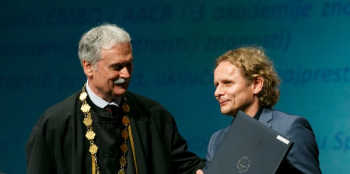14 Jun 2019 - Ivan Đikić receives honorary doctorate from Split University
IBC2 Director Ivan Đikić received a honorary doctorate from Split University in a festive ceremony today, acknowledging his exceptional contribution to promoting science at Split University.
Since 2002, Ivan has built strong links with Split University’s School of Medicine, being a professor from 2002 till 2017, organizing multiple scientific events, promoting an active exchange and scientific collaborations with GU Frankfurt and – until recently – sustaining an outstation laboratory.
The shared passion for science of Frankfurt- and Split-based scientists has led to several high-impact publications already, with more to come. “Looking back I am feeling proud on what we achieved together with colleagues and friends from Frankfurt and Split Universities”, commented Ivan who felt truly touched by receiving the honorary doctorate, which is also the first in his career.
